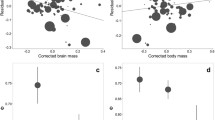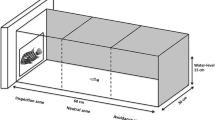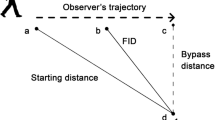Abstract
The relationship between body mass and reactions speed in response to a predatory threat is poorly understood. Theory predicts that different vigilance patterns are optimal for the detection of different predator types. We suggest that birds of different individual state might also differ in their speed of response dependent upon predator type. We used laboratory trials of wild caught chaffinches (Fringilla coelebs) to determine how between individual differences in chaffinch behaviour and state correlate with latency to react to a ground predator model (domestic cat), thus providing a comparison with previous work in the same model system using aerial predator models. In experiment 1, we observed chaffinch responses to a moving cat model, simulating a stalking predator. In experiment 2, we used a camouflaged cat model simulating an ambush predator. Both experiments show evidence suggesting heavier individuals (which previous literature has linked to impaired flight performance) responded more quickly to the model cat. Heavier individuals also had shorter interscan intervals. In contrast to a previous study, both experiments found individuals with a higher intake rate were not faster at responding to the cat model. In addition, individuals in experiment 1 that head turned more while scanning were slower to respond to the stalking cat model. Our work suggests that although heavier individuals may have impaired escape performance they appear to show behavioural compensation by allocating more attention to anti-predator behaviour and by modifying their interscan intervals, resulting in faster response times to a ground predator. We suggest more experiments investigating response time to different predatory types and explicitly manipulating state to elucidate cause and effect.





Similar content being viewed by others
References
Alvarez F (1993) Alertness signalling in 2 rail species. Anim Behav 46:1229–1231
Bednekoff PA (1996) Translating mass dependent flight performance into predation risk: an extension of Metcalfe & Ure. Proc R Soc Lond B Biol Sci 263:887–889
Bednekoff PA, Houston AI (1994) Avian daily foraging patterns: effects of digestive constraints and variability. Evol Ecol 8:36–52
Bednekoff PA, Lima SL (2002) Why are scanning patterns so variable? An overlooked question in the study of anti-predator vigilance. J Avian Biol 33:143–149
Bischof HJ (1988) The visual-field and visually guided behavior in the zebra finch (Taeniopygia guttata). J Comp Physiol [A] 163:329–337
Blumstein DT, Evans CS, Daniel JC (2000) JWatcher 0.9. An introductory users guide. Animal Behaviour Laboratory, MacQuarie University, Sydney
Clark CW, Dukas R (2003) The behavioural ecology of a cognitive constraint: limited attention. Behav Ecol 14:151–156
Cohen J (1988) Statistical power analysis for the behavioural sciences, 2nd edn. Erlbaum, Hillsdale, NJ
Cresswell W (1993) Escape responses by redshanks, Tringa totanus, on attack by avian predators. Anim Behav 46:609–611
Cresswell W, Quinn JL, Whittingham MJ, Butler S (2003) Good foragers can also be good at detecting predators. Proc R Soc Lond B 270:1069–1076
Devereux CL, Whittingham MJ, Fernandez-Juricic E, Vickery JA, Krebs JR (2006) Predator detection and avoidance by starlings under differing scenarios of predation risk. Behav Ecol 17:303–309
Dukas R, Kamil AC (2000) The cost of limited attention in blue jays. Behav Ecol 11:502–506
Ekman JB, Hake MK (1990) Monitoring starvation risk: adjustments of body reserves in greenfinches (Carduelis chloris L.) during periods of unpredictable foraging success. Behav Ecol 1:62–67
Fernandez-Juricic E, Tran E (2007) Changes in vigilance and foraging behaviour with light intensity and their effects on food intake and predator detection in house finches. Anim Behav 74:1381–1390
Fernandez-Juricic E, Jiminez MD, Lucas E (2002) Factors affecting intra- and inter-specific variations in the difference between alert distances and flight distances for birds in forested habitats. Can J Zool 80:1212–1220
Fernandez-Juricic E, Erichsen JT, Kacelnik A (2004) Visual perception and social foraging in birds. Trends Ecol Evol 19:25–31
Fitzgerald BM, Turner DC (2000) Hunting behaviour of domestic cats and their impact on prey populations. In: Tuner DC, Bateson P (eds) Domestic cat: the biology of its behaviour. Cambridge University Press, Cambridge
Hart NS (2001) Variations in cone photoreceptor abundance and the visual ecology of birds. J Comp Physiol A Neuroethol Sens Neural Behav Physiol 187:685–697
Hart A, Lendrem DW (1984) Vigilance and scanning patterns in birds. Anim Behav 32:1216–1224
Hasson O (1991) Pursuit-deterrent signals—communication between prey and predator. Trends Ecol Evol 6:325–329
Hurd CR (1996) Interspecific attraction to the mobbing calls of black capped chickadees (Parus atricapillus). Behav Ecol Sociobiol 38:287–292
Jones KA, Whittingham MJ (2008) Anti-predator signals in the chaffinch Fringilla coelebs in response to habitat structure and different predator types. Ethology 114:1033–1043
Jones KA, Krebs JR, Whittingham MJ (2007) Vigilance in the third dimension: head movement not scan duration differs in response to different predator models. Anim Behav 74:1181–1187
Kaby U, Lind J (2003) What limits predator detection in blue tits (Parus caeruleus): posture, task or orientation? Behav Ecol Sociobiol 54:534–538
Kenward RE (1978) Hawks and doves—factors affecting success and selection in goshawk attacks on woodpigeons. J Anim Ecol 47:449–460
Krams I (2002) Mass-dependent take-off ability in wintering great tits (Parus major): comparison of top-ranked adult males and subordinate juvenile females. Behav Ecol Sociobiol 51:345–349
Krams I, Krama T (2002) Interspecific reciprocity explains mobbing behaviour of the breeding chaffinches, Fringilla coelebs. Proc R Soc Lond B Biol Sci 269:2345–2350
Krause J, Godin JGJ (1996) Influence of prey foraging posture on flight behavior and predation risk: predators take advantage of unwary prey. Behav Ecol 7:264–271
Kullberg C (1998) Does diurnal variation in body mass affect take-off ability in wintering willow tits? Anim Behav 56:227–233
Kullberg C, Fransson T, Jakobsson S (1996) Impaired predator evasion in fat blackcaps (Sylvia atricapilla). Proc R Soc Lond B Biol Sci 263:1671–1675
Lendrem DW (1983) Predation risk and vigilance in the blue tit (parus caeruleus). Behav Ecol Sociobiol 14:9–13
Lima SL (1987) Vigilance while feeding and its relation to the risk of predation. J Theor Biol 124:303–316
Lima SL, Bednekoff PA (1999) Back to the basics of antipredatory vigilance: can nonvigilant animals detect attack? Anim Behav 58:537–543
Lind J, Cresswell W (2005) Determining the fitness consequences of antipredation behavior. Behav Ecol 16:945–956
Lind J, Fransson T, Jakobsson S, Kullberg C (1999) Reduced take-off ability in robins (Crithacus rubecula) due to migratory fuel load. Behav Ecol Sociobiol 46:65–70
MacLeod R (2006) Why does diurnal mass change not appear to affect the flight performance of alarmed birds? Anim Behav 71:523–530
Marler P (1956) Behaviour of the chaffinch, Fringilla coelebs. Behav Suppl 5:1–184
Martin GR, Jarrett N, Tovey P, White CR (2005) Visual fields in flamingos: chick-feeding versus filter-feeding. Naturwissenschaften 92:351–354
McNamara JM, Houston AI (1990) The value of fat reserves and the tradeoff between starvation and predation. Acta Biother 38:37–61
Metcalfe NB, Ure SE (1995) Diurnal-variation in-flight performance and hence potential predation risk in small birds. Proc R Soc Lond B Biol Sci 261:395–400
Nakagawa S, Cuthill IC (2007) Effect size, confidence interval and statistical significance: a practical guide for biologists. Biol Rev 82:591–605
Nystrand O, Granstrom A (1997) Post-dispersal predation on Pinus sylvestris seeds by Fringilla spp: ground substrate affects selection for seed color. Oecologia 110:353–359
Perez-Tris J, Diaz JA, Telleria JL (2004) Loss of body mass under predation risk: cost of antipredatory behaviour or adaptive fit-for-escape? Anim Behav 67:511–521
Pulliam HR (1973) On the advantages of flocking. J Theor Biol 38:419–422
Quinn JL, Cresswell W (2005) Escape response delays in wintering redshank, Tringa totanus, flocks: perceptual limits and economic decisions. Anim Behav 69:1285–1292
Scannell J, Roberts G, Lazarus J (2001) Prey scan at random to evade observant predators. Proc R Soc Lond B Biol Sci 268:541–547
Schwarzkopf L, Shine R (1992) Costs of reproduction in lizards—escape tactics and susceptibility to predation. Behav Ecol Sociobiol 31:17–25
Siegfried WR, Underhill LG (1975) Flocking as an anti-predator strategy in doves. Anim Behav 23:504–508
Treherne JE, Foster WA (1980) The effects of group-size on predator avoidance in a marine insect. Anim Behav 28:1119–1122
Van der Veen IT, Lindstrom KM (2000) Escape flights of yellowhammers and greenfinches: more than just physics. Anim Behav 59:593–601
Veasey JS, Metcalfe NB, Houston DC (1998) A reassessment of the effect of body mass upon flight speed and predation risk in birds. Anim Behav 56:883–889
Whitfield DP (2003) Redshank tringa totanus flocking behaviour, distance from cover and vulnerability to sparrowhawk Accipiter nisus predation. J Avian Biol 34:163–169
Whittingham MJ, Butler S, Quinn JL, Cresswell W (2004) The effect of limited visibility on vigilance behaviour and speed of predator detection: implications for the conservation of granivorous passerines. Oikos 106:377–385
Witter MS, Cuthill IC, Bonser RHC (1994) Experimental investigations of mass-dependent predation risk in the European starling, Sturnus vulgaris. Anim Behav 48:201–222
Woods M, McDonald RA, Harris S (2003) Predation of wildlife by domestic cats Felis catus in Great Britain. Mamm Rev 33:174–188
Acknowledgements
We would like to thank Matt Denny, Matt Wood and Julian Howe for their help catching chaffinches. We also thank Dave Wilson for animal husbandry. Katherine Jones was funded by a British Biological Sciences Research Council Studentship and Mark Whittingham by a British Biological Sciences Research Council David Phillips Research Fellowship.
Author information
Authors and Affiliations
Corresponding author
Additional information
Communicated by J. Lindström
Rights and permissions
About this article
Cite this article
Jones, K.A., Krebs, J.R. & Whittingham, M.J. Heavier birds react faster to predators: individual differences in the detection of stalking and ambush predators. Behav Ecol Sociobiol 63, 1319–1329 (2009). https://doi.org/10.1007/s00265-009-0778-6
Received:
Revised:
Accepted:
Published:
Issue Date:
DOI: https://doi.org/10.1007/s00265-009-0778-6




